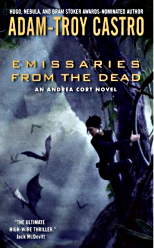'Recount' Stars Voting Machine That Doomed Gore
Over the holiday weekend, my wife M.C. Moewe wrote a news story for the Daytona Beach News-Journal on the Volusia County optical scan voting machine that registered 16,000 negative votes for Al Gore right as the networks were scrambling to decide who won Florida:
HBO's new docudrama Recount stars Kevin Spacey and Denis Leary, but the real scene-stealer hails from Volusia County -- a voting machine that registered 16,000 negative votes for Al Gore in the wee hours of election night 2000.
"A machine in Volusia went crazy," says Leary in the film, portraying a Gore campaign strategist. "It actually added 3,000 votes to Bush's total and subtracted thousands of votes from Gore. I mean Gore's count right now is negative 16,000 in that county."
What caused the voting machine memory card glitch is not a topic in the account that premieres tonight at 9 o'clock. In fact, it still remains unknown and begs the question: Could it happen again? ...
At the time, employees with the machine's maker said in internal e-mails that an unknown "second" memory card caused the problem. After inquiries from The News-Journal, officials with Diebold Inc.'s Premier Election Solutions recently said there is a problem with a part on the machines in question -- 25,000 are used across the U.S -- which could cause memory card failures.
In Volusia County, the same "crazy" optical scan machines that delivered Gore's negative vote total are still in use.
The negative votes in 2000 could have been caused by four problems according to internal e-mails written by the machine's manufacturer, then called Global Election Systems. A corrupt memory card, an invalid read from a good card, corruption of memory or a card from an "un-authorized source."
As a programmer, I've never understood how Diebold's voting software accepted negative votes and lowered a candidate's total. You'd think the logical impossibility would've caused the input to be rejected before it altered the course of American history.
Following Web Page Redirects with Java
CNET moved a bunch of its blogs to a different domain this weekend, including Beyond Binary, Coop's Corner, Geek Gestalt, One More Thing, Outside the Lines and The Social. I mention this because the change hosed Meme13, which treated all six as if they were newly discovered sites.
One of my ground rules for developing Meme13 is that I won't hand-edit the site to make it smarter. I need the application to recognize when existing sites in its database have moved.
Meme13 monitors sites using a Java application I wrote that downloads web pages with the Apache HTTPClient 3.0 class library. Web servers indicate that a page has moved by sending an HTTP redirect response of either "301 Moved Permanently," which indicates a permanent move, or "302 Found," which is intended for temporary changes. I wrote a Java method that can find the current location of a web page, even if it has been redirected one or more times:
public String checkFeedUrl(String feedUrl) {
String response = feedUrl;
HttpClient client = new HttpClient();
HttpMethod method = new HeadMethod(feedUrl);
method.setFollowRedirects(false);
try {
// request feed
int statusCode = client.executeMethod(method);
if ((statusCode == 301) | (statusCode == 302)) {
// feed has moved
Header location = method.getResponseHeader("Location");
if (!location.getValue().equals("")) {
// recursively check URL until it's not redirected any more
response = checkFeedUrl(location.getValue());
}
} else {
response = feedUrl;
}
} catch (IOException ioe) {
response = feedUrl;
}
return response;
}
The HeadMethod class requests a web page's headers instead of requesting the entire page, consuming far less bandwidth as it checks for redirects. My Java method looks for both kinds of redirects, because web publishers have a bad habit of using "302 Found" when they've moved a page permanently.
Any Reason Why These Two Should Not Be Wed?
Today's New York Times has an amazing sequence of photos taken by a wedding photographer in Bailu, China, during the May 12 earthquake. Five impeccably dressed Chinese couples were getting their photos taken at an abandoned French missionary church as the disaster struck.
There are more photos on a Chinese-language media site. Photographer Wang Qiang's caption for one photo, which he posted on his blog: "What is happiness, happiness is safe and sound. Having gone through a life-and-death test, they surely will clasp hands and grow old together."
Review: Emissaries from the Dead by Adam-Troy Castro
 While in college in the late '80s I freelanced for Amazing Heroes, a comics magazine that paid slightly more than the postage required to mail the checks. I was part of a reviewing stable that included Adam-Troy Castro, a writer with a misplaced hyphen who recently wrote Emissaries from the Dead, his first science fiction novel set in a world of his own making.
While in college in the late '80s I freelanced for Amazing Heroes, a comics magazine that paid slightly more than the postage required to mail the checks. I was part of a reviewing stable that included Adam-Troy Castro, a writer with a misplaced hyphen who recently wrote Emissaries from the Dead, his first science fiction novel set in a world of his own making.
Emissaries, which is subtitled "An Andrea Cort Novel," carries forward a protagonist and setting from his short stories. The world's wonderfully bizarre, an artificial planet built on the inside of a miles-long cylinder by millenia-old sentient software called the AIsource. Each advanced civilization explores space first with its software, and this code has outlived its coders, joining together with programs from other worlds to form one megabloated Windows release that controls the universe.
The software has engineered sloth-like, spider-armed primates who hang from the vines and roots growing on the outer edge of the world, surviving only as long as they can hold on. These creatures are called Brachiators, from the verb brachiate, and they're the most fascinating thing about the novel.
The battlefield was a patch of Uppergrowth indistinguishable from any other, marked only by the thirty nearly immobile figures wrapped in what their species must have considered to be frenetic combat. There were two groups, whose paths prior to this moment in their respective histories were easy to track by the vines they'd shredded in their wake. They hadn't collided head-on, but rather at an angle, joining in battle as soon as both tribes realized that they'd now be competing for the same patch of their world's ceiling.
The fresh, juicy manna pears hanging in bunches from every vine in sight revealed the conflict as ridiculous, as even Brachiators forced into a course change could have found more food than they could possibly eat within an hour's travel, but that didn't matter to them; their armies had met, and their war had to be fought. ...
The Brachiator battlefield looked like an orgy where everybody had fallen asleep in mid-hump.
Unfortunately, the Brachiators aren't the focus. The novel's about two murders that take place in the small colony of human researchers sent to the planet. Cort's an unloved diplomat sent to solve the crimes without implicating the AIsource, and the bulk of the 386-page novel consists of her talking to potential suspects and interacting with the AIsource, who pose a constant threat to go all deus ex machina and kill the suspense. Castro's story is all talk, ending with Cort's uninterrupted six-page Scooby Doo monologue on how she solved the crimes.
Despite the weaknesses in plotting, Castro's setting carries the book and makes the prospect of another "Andrea Cort novel" intriguing. She just needs a mystery that hangs on a species as compelling as the Brachiators.
Setting the Link on a ShareThis Widget
 I'm continuing to work on Meme13, a site that packages together the last 13 sites to show up on the Techmeme Leaderboard so they can be sampled as a feed or web site. The site has attracted around 25 RSS subscribers in its first month.
I'm continuing to work on Meme13, a site that packages together the last 13 sites to show up on the Techmeme Leaderboard so they can be sampled as a feed or web site. The site has attracted around 25 RSS subscribers in its first month.
I've added a ShareThis widget on each entry that makes it easy to share content from Meme13 on sites like De.licio.us, Digg and Facebook.
Normally, ShareThis links to the page the widget has been displayed on. That doesn't suit my purposes on Meme13, because I'm trying to promote the originators of the content. If someone reads the article about landing a startup job by Ryan Spoon on Meme13, the ShareThis widget should link to the article on Spoon's blog.
ShareThis has a JavaScript API that can be used to teach the widget new tricks. Here's the JavaScript code to set the widget's target link and display the widget:
<p><script language="javascript" type="text/javascript">
SHARETHIS.addEntry({
title:'<TMPL_VAR title>',
url:'<TMPL_VAR link ESCAPE="HTML">',
}, {button:true} );
</script></p>
The <TMPL_VAR title> and <TMPL_VAR link ESCAPE="HTML"> tags are part of the template language used by Planet Planet, the software that publishes Meme13. Here's how the same thing could be done in PHP:
<p><script language="javascript" type="text/javascript">
SHARETHIS.addEntry({
title:'<? echo $site_title; ?>',
url:'<? echo $site_link; ?>',
}, {button:true} );
</script></p>
Boston Herald Should Name Its SpyGate Source
On Wednesday, the Boston Herald apologized for a Feb. 2 story by John Tomase that reported the New England Patriots surreptitiously videotaped the St. Louis Rams' walkthrough practice before Super Bowl XXXVI in 2002.
While the Boston Herald based its Feb. 2, 2008, report on sources that it believed to be credible, we now know that this report was false, and that no tape of the walkthrough ever existed.
Prior to the publication of its Feb. 2, 2008, article, the Boston Herald neither possessed nor viewed a tape of the Rams’ walkthrough before Super Bowl XXXVI, nor did we speak to anyone who had. We should not have published the allegation in the absence of firmer verification.
For the story, Tomase took the word of "a source close to the team during the 2001 season." In today's Herald, Tomase explains how he got the story wrong, but he leaves out the only real detail that matters -- the name of the person who passed along bogus information.
There has been a clamoring for me to identify the sources used in my story. This I cannot do. When a reporter promises anonymity, he can't break that promise simply because he comes under fire. I gave my word, and the day I break that word is the day sources stop talking to me.
Another word on sources: The story mentioned only a single, unnamed source because in the end, while I had multiple sources relating similar allegations, I relied on one more than the others.
I've never understood why journalists hide the names of sources who use the shield of anonymity to spread falsehoods. The agreement between a reporter and an unnamed source, like that of a criminal plaintiff accepting a plea deal to testify in court, should be conditioned on the information being truthful. A source who lies should know that it might blow up in his face. Tomase and the Herald are getting murdilated over running a fake story on the eve of the Patriots' defeat in the Super Bowl. The source remains on the loose.
Reporters have grown far too addicted to the access granted by sources who won't comment for attribution. Instead of digging around from the outside, they act as stenographers to well-connected people with inside information.
In the early '90s, I was an editor at StarText, the Fort Worth Star-Telegram's online newspaper. As I prepared stories for publication, I could see the "CQ notes," memos between editors and reporters that were embedded in the articles and removed before publication.
These notes sometimes revealed the identity of unnamed sources in our coverage of the Dallas Cowboys.
More than 15 years have passed, so I can probably reveal this without getting myself into trouble: The Star-Telegram's unnamed source "close to the organization" was owner Jerry Jones. The Dallas Morning News' unnamed source, according to our reporters, was head coach Jimmy Johnson. The two leading figures on the team were waging a furious battle in the press, using the cover of anonymity and pliant newspapers to keep from having to answer for their words.
But if I've said too much here, just tell people you got this information from a source close to the Star-Telegram.
Alison La Placa Threatens Television Death Pool
 For the last nine years, Mike Burger has run an online contest to predict the shows that will be cancelled during the TV season. He named it the Alison La Placa Open Television Death Pool, honoring the actress who's known as a sitcom killer for being a regular cast member on so many short-lived comedies: Suzanne Pleshette Is Maggie Briggs, Duet, Open House, Stat, The Jackie Thomas Show and Tom.
For the last nine years, Mike Burger has run an online contest to predict the shows that will be cancelled during the TV season. He named it the Alison La Placa Open Television Death Pool, honoring the actress who's known as a sitcom killer for being a regular cast member on so many short-lived comedies: Suzanne Pleshette Is Maggie Briggs, Duet, Open House, Stat, The Jackie Thomas Show and Tom.
I entered this year's La Placa and have proven to be one of its worst players, predicting these cancellations:
- Samantha Who (ABC)
- Cavemen (ABC)
- Moonlight (CBS)
- Viva Laughlin (CBS)
- Scrubs (NBC)
- Medium (NBC)
- Back to You (FOX)
- Chuck (NBC)
- 'Til Death (FOX)
- According to Jim (ABC)
Only three of those shows have gotten the axe: Cavemen, Moonlight and Viva Laughlin. Cheers writer Rob Long is in first place, failing only to anticipate the inexplicable survival of According to Jim.
Last month, the contest's name became the Cease and Desist Television Pool after Burger was contacted by La Placa's attorney. "Seems either the previous honoree, or more importantly her lawyer, decided I was harming her, ahem, career," Burger announced. I would've thought by now that La Placa was impervious to harm -- after all, this is an actress whose career has survived her decision to star in two different Tom Arnold sitcoms.
The contest is now known as the Ted Marshall Open Television Death Pool. The new name's a fake in an attempt to avoid litigation, as Burger explains on his blog, but my guess is that he's honoring two other legendary show killers, Ted McGinley and Paula Marshall.


